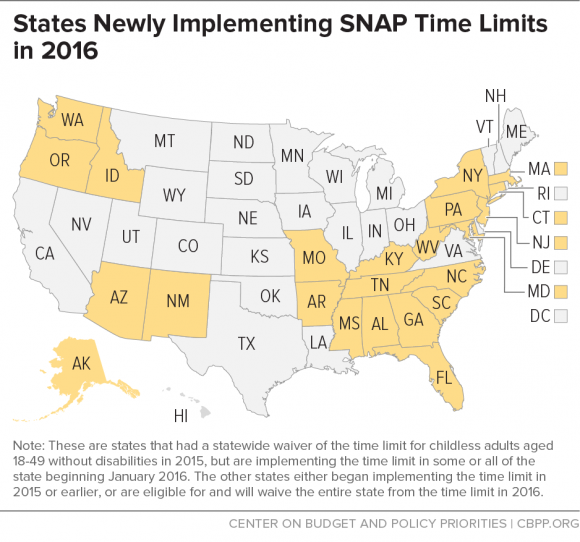About two and a half years ago, I wrote a thorough piece on reforming the Supplemental Nutrition Assistance Program (SNAP), or what is commonly referred to as food stamps. I went through ten possible means of reform, and I concisely analyzed each one. Considering the issues that come with SNAP, one can only hope that reform takes place. Since I wrote that entry, one of the reforms actually came into fruition. Over the course of 2016, 23 states will have implemented time limits of three months on receiving SNAP benefits (see map below). This will bring the count to 40 states with time limits. The time limit statute originates from the 1996 welfare law, and had a provision that stated that states can waive the time limit on a state-by-state basis if unemployment is unusually high. Since unemployment has been dropping in many states, the waiver no longer applies for those states, hence the reinstatement of the time limits.
The purpose of the time limit via a work requirement is to incentivize individuals to regain employment shortly after losing their initial job. This incentive exists in order that individuals don't become dependent on government welfare, and so that what is supposed to be a safety net can remain solvent in the long-run. There are those, such as the analysts from the Left-leaning Center for Budget and Public Priorities (CBPP), that view the work requirements as too punitive. From the CBPP's point of view, the work requirements are a severe time limit that should not be punishing those who are actively looking for work, but simply cannot find work.
What comes off as punitive to some might actually be necessary for the longevity of the program. Much like with unemployment benefits, food stamps create a disincentive to work. Using the most recent data from the US Department of Agriculture (USDA), one can see that from 2008 to 2012, 52 percent of SNAP recipients had been on food stamps for over two years. Although the data are not as recent, we can use a time period in which a) countercyclical demand would boost the need for SNAP benefits, and b) a time period in which the vast majority of states removed their time limits. Although the Great Recession played a role, what really helped bolster SNAP benefit recipient numbers was increasingly lax eligibility requirements and active outreach from the USDA to recruit more recipients. Using USDA data [Table A.16], we can also see that 83.1 percent of adults who are capable of work and have no dependable children (ABAWDs) who are on SNAP don't work. A lack of work requirements reduces the number of people working (Hoynes and Schanzenbach, 2011). The State of Kansas serves as an example of how reinstating work requirements increased the likelihood of ABAWDs who are SNAP benefit recipients to actually go to work (Ingram and Horton, 2016).
Not only would this help individuals get off of government dependency, but it would help from a budgetary standpoint. Looking at Congressional Budget Office (CBO) projections, the budget outlays for SNAP are not expected to significantly decrease over the next decade. According to the Right-leaning Heritage Foundation, reinstating work requirements for ABAWDs would create an estimated savings of $9.7 billion annually. I would agree with the CBPP that there should be better job training opportunities for SNAP recipients (particularly for those who are extremely poor), but I still contend that social safety nets should not devolve into long-term dependency on government benefits. Social safety nets should encourage and expect people who are readily available to work to do so. Without such incentives as work requirements, we merely perpetuate the cycle of economic stagnation and frustration for a sizable number of Americans.

No comments:
Post a Comment